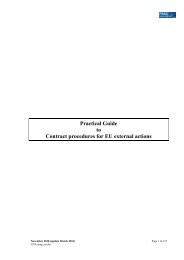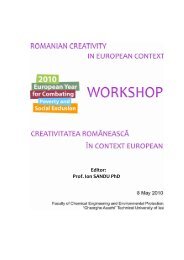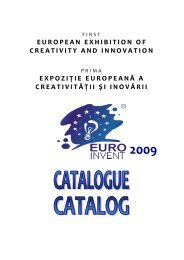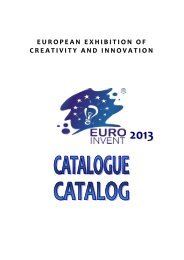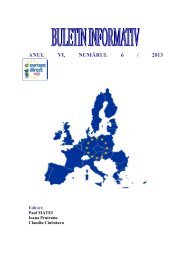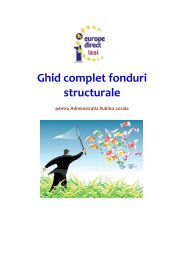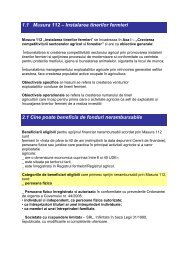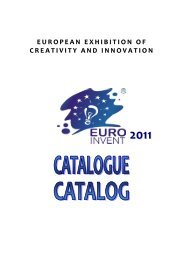2012 - Europe Direct Iasi
2012 - Europe Direct Iasi
2012 - Europe Direct Iasi
You also want an ePaper? Increase the reach of your titles
YUMPU automatically turns print PDFs into web optimized ePapers that Google loves.
EUROINVENT <strong>2012</strong><br />
are temporary. due to rapid acceleration in the erosion of<br />
competitive advantage in almost all businesses can be traced<br />
back to developing new technologies quickly. Since more than<br />
death is sudden new business models that have been rapidly<br />
challenging the current leaders leverage the special skills that<br />
enable them to invade and conquer the market more targeted<br />
customer segments. This research program provides a broad<br />
literature review to identify the latest trends in e-SCM. Also, try<br />
to study some of the problems associated with e-SCM, along<br />
with their solutions and practices.<br />
X. 10.<br />
Title<br />
Study regarding the effects of acid etching on enamel affected by<br />
non-cavitated carious lesions<br />
Authors Stoleriu Simona, Pancu Galina<br />
Institution<br />
University of Medicine and Pharmacy „Gr.T.Popa”-Iassy,<br />
Romania, Faculty of Dental Medicine<br />
The aim of the study was to establish and to compare the effects<br />
of ortophosphoric acid and hydrochloric acid on enamel affected<br />
by incipient carious lesions with different evolution. 20 teeth<br />
having acute and chronical non-cavitated carious lesions were<br />
used in this study. The teeth were sectioned in two halves<br />
through the middle of the non-cavitated lesions. The halves of 5<br />
white spot lesions and of 5 brown spot lesions were analyzed<br />
using an atomic force microscope (AFM) to establish the surface<br />
roughness. 5 halves with white spot lesions and 5 halves with<br />
brown spot lesions were etched using 37% ortophosphoric acid<br />
(Scotchbond etchant gel, 3M ESPE), and an equal number of<br />
Description samples were etched using 15% hydrochloric acid (ICON-etch,<br />
DMG Dental Products Ltd) for 2 min, then washed with water<br />
and analyzed by AFM. The initial surface roughness of the<br />
enamel was higher in the white spot lesions, comparatively with<br />
the brown lesions. For both types of non-cavitated lesions, acid<br />
etching with phosphoric and hydrochloric acid significantly<br />
increased the surface roughness of the enamel when comparing<br />
with the enamel surface before etching. The hydrochloric acid<br />
led to a surface roughness significantly higher than<br />
ortophosphoric acid, in both acute and chronical non-cavitated<br />
carious lesions. The roughness values obtained after etching with<br />
ortophosphoric and hydrochloric acid were higher in the white<br />
spot lesions, when comparing with brown spot lesions.<br />
X. 11.<br />
Title<br />
Studies on water footprint assessment in the sustainable water<br />
resources management<br />
Authors Simona-Andreea Ene, Carmen Teodosiu<br />
Innovative Researches<br />
170





